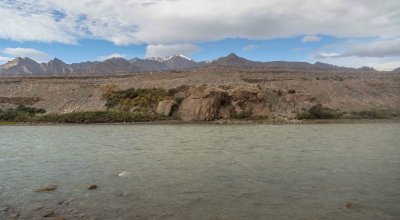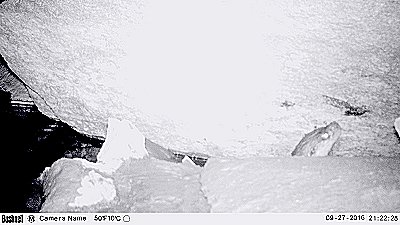IUCN/SSC Otter Specialist Group Bulletin

|
©IUCN/SCC Otter Specialist Group
Volume 33 Issue 2 (October 2016) Citation: Jamwal, PS, Takpa, J, Chandan, P and Savage, M (2016). First Systematic Survey for Otter (Lutra lutra) in Ladakh, Indian Trans Himalayas. IUCN Otter Spec. Group Bull. 33 (1): 79 - 85 First Systematic Survey For Otter (Lutra lutra) In Ladakh, Indian Trans Himalayas Pushpinder Singh Jamwal1, Jigmit Takpa2, Pankaj Chandan1, and Melissa Savage3
1 Western Himalayas Landscape, WWF-India. e-mail
pushpindersjamwal@gmail.com |
    |
| (Received 16th June 2016, accepted 24th October 2016) |
| Abstract: We report the findings of the first survey for Eurasian otter (Lutra lutra) from the Upper Indus River and several of its tributaries in Leh and Kargil Districts, India. The survey was conducted between 25th August to 30th October, 2015. We report the distribution of otter sign, including camera trap images, scats, tracks, and latrines, and the habitat characteristics along 50 km of riverbank. We observed indirect sign of otter presence on two of the four rivers surveyed, but otter abundance appears to be low in the area. Human disturbance, including proximity to settlements, grazing livestock, and particularly feral dogs, appears to deter otter presence. |
| Keywords:Eurasian otter, Lutra lutra, Western Himalaya landscape, Indus River, Dras River |
| Française | Español |
INTRODUCTION
The presence of otters in the Upper Indus River Valley of Ladakh, India, has only been reported anecdotally to date. Ladakh is a region in the northernmost Indian State of Jammu and Kashmir, on the western edge of the Tibetan Plateau. The great trough of the Upper Indus River Valley runs between the Zanskar Mountains, north of the Great Himalaya Range, and south of the Ladakh Mountains, a part of the Karakoram Range. The Indus originates in the Chinese portion of the Tibetan Plateau and flows west through Ladakh, continuing in a great arc to the south into Pakistan, where it provides the largest share of irrigation waters for that country. It is already a large river in the Ladakh valley, fed by glaciers, fluctuating significantly with the season of meltwater, and nearly freezing over during the deep Ladakhi winter. Tributaries to the Indus are large rivers in themselves, some more than 30 m wide.
The Ladakh Valley is a high-elevation, trans-himalayan desert in the rain shadow of the Himalayas, with sparse precipitation, ~10 cm annually, coming mostly as snow in winter. Summers are short and can be hot, with temperatures ranging from 3° to 35° C, while winters are long and bitterly cold, with temperatures that drop to -35° C or lower. Natural vegetation is sparse, except along waterways.
Anecdotal records of Pfister (2004) and Shawl et al. (2008) report the occurrence of the Eurasian otter in Ladakh, but no systematic surveys had as yet been conducted to confirm their distribution in the region. Shawl et al. (2008) state that the otter in Ladakh may be found along the Indus River and its tributaries, the lower Zanskar and Rumtse Rivers, and in the Suru and Dras River valleys in the Kargil area, up to 3,500 m asl. Conversations with both otter scientists and local people suggested that otters historically occupied the Upper Indus, but possibly had been extirpated.
Locally known as chusham in Ladakh and chustam in Kargil, the Eurasian otter is said to be nocturnal and may migrate to lower elevations in winter (Shawl et. al., 2008). Locals readily recognize a description of the animal, but few reported seeing an otter in recent years. As a consequence, the otter has not been a species of concern for management agencies, and therefore not offered the same conservation attention afforded to other charismatic fauna, such as the Snow Leopard (Panthera uncia). Otter populations are declining throughout Asia and the Himalayan region, subject to human pressure on water resources, fragmentation of habitat, and the illegal pelt trade (Foster-Turley et al., 1990; Yoxon, 2007; Kafle, 2009; de Silva, 2011). We had two objectives: 1) to document the distribution and density of otter sign - tracks, scats, and latrines, and 2) to examine the association of vegetation, bankside strata and human disturbances with otter sign.
STUDY AREA
Survey stretches were selected based on anecdotal otter observations in the literature (Pfister, 2004; Shawl et al., 2008). Four river stretches were chosen to reflect these reports, including, (1) the Indus River (from the towns of Leh to Upshi); (2) the Suru River (tributary to the Indus River) near the town of Kargil, (3) the Dras River (above the confluence with the Suru River) and (4) the Zanskar River (above the confluence with the Indus River). The town of Leh is located at 3,524 m asl, and the downstream town of Kargil at 2,676 m asl. (Figure 1).

|
| Figure 1.Map of surveyed river stretches in Ladakh, India (click for larger version) |
METHODOLOGY
A total of 50 plots were sampled: 20 plots along the mainstem Indus River, 5 plots along Suru, 10 plots along the Dras River, and 15 plots along Zanskar River. Each plot ran along the river bank for 100 m and 10 m in from the river edge for a 1,000 m2 plot. Plots were placed 900 m apart on a transect on one bank of the river. Sampling was conducted in September, when river flows are dropping, leaving mud and sand banks exposed to record otter sign. As the survey proceeded, it became apparent that otter sign was relatively scant, so if terrain allowed, a complete transect along the bank was covered. This was possible on the Indus, Suru and Dras Rivers, but not on the Zanskar River.
Within each plot, we searched for otter sign. A plot was considered ‘positive’ for otter sign if tracks, scats, or latrines were found. Scat was identified by the presence of fish bones and scales and a fishy odor. Latrines, displaying multiple scat and tracks, were usually located on large boulders near the water’s edge. Tracks were identified by a round impression of five toes and faint webbing marks; only positively identified otter tracks were recorded.
Otters are sensitive to habitat characteristics, preferring sites with vegetation or large boulders for protected resting sites, sandy beaches or vegetation for rolling and drying, and large flat rocks near the waterline on which they consume their prey. We sampled for vegetation cover (classified as 0-5%, >5-25%, >25-50%, >50-75%, and >75-100%) and bank substrate (classified by diameter as < 1 cm (sand and mud), 1-10 cm (small stones), >10 cm - .5 m (large stones), >.5 m (boulders). Mean vegetation cover and mean substrate composition were calculated by averaging the mid-point of each percent cover category. Habitat disturbance (characterized by abundance of dog and cow tracks, trash, and proximity to houses) was recorded as none, light, moderate, or severe, and expressed as a porportion (total percentages may not equal 100% because of use of mid-points of values in calculations).
RESULTS
Otter scat, latrines, and tracks were recorded at two of the four survey stretches, the mainstream Indus and Dras Rivers and later otter camera trap images were captured at one of the four survey stretches (Fig. 1).
Indus River site: The Indus River flows east-west through the centre of the Ladakh valley, past a series of small villages, where it frequently splits into multiple channels and is diverted by canals for irrigating crops and orchards (Fig. 2). Clumpy, often impenetrable thickets of seabuckthorn (Hippophae spp.) are common on or near banks, as are domesticated Lombardy poplars (Populus spp.) and willow trees (Salix spp.). These vegetation communities, together with sandy and cobbly beaches, can provide good intermittent habitat for otter resting and denning sites. Mean vegetation cover varied considerably along the site, with 55% bare, 7% light, 7% moderate, 10% mostly, 14% heavy vegetation cover. Mean substrate at the site was: 32% sand and mud, 22% small stones, 17% large stones, and 15% boulders. Human impact was: 15% none, 60% light, 15% moderate, and 2% severe.

|
| Figure 2. Upper Indus River near the town of Leh, Ladakh. (click for larger version) |
Dras River site: The Dras River was surveyed from its confluence with the Suru River, near the town of Kargil, upstream for 10 km. Bankside terrain was primarily steep slopes, but the river's edge primarily consisted of jumbles of large boulders and small sandy beaches. Mean vegetation cover was: 88% nearly bare, 4% light, 3% moderate, 3% mostly, and 3% heavy vegetation cover. Mean substrate at the site was: 8% silt and mud, 8% small stones, 14% large stones, and 75% boulders. Human impact was quantified at 70 % none and 30% light.
Zanskar and Suru River sites: No otter sign was found at the Zanskar or Suru study sites.
The Zanskar runs through a deep narrow gorge within the Zanskar Range to join the Indus River below Leh. The site was surveyed for 15 km upriver from the confluence with the Indus River. The most common waterline is formed by sheer rock and enormous boulders that front directly onto the river, providing little otter habitat. There is virtually no vegetation near the river bank along this reach of river, and the river runs narrow and fast, with numerous rapids. Sandy coves are scattered intermittantly along the river, but these showed no tracks or scat of otters. Along the Zanskar River, mean vegetation cover was: 84% nearly bare, 3% light, 3% moderate, 5% mostly, 3% heavy vegetation cover. Mean substrate at the site was: 22% sand and mud, 25% small stones, 20% large stones, and 34% boulders. Human impact was: 87% none and 13% light.
The Suru River was surveyed for 5 km downstream from the town of Kargil. The narrow banksides were a mix of large and small boulders and rarely, small sand beaches. No otter sign was found at the Suru site. This may be attributed to the proximity of a busy town, located on both sides of the river. Mean vegetation cover consisted of 66% nearly bare, 12% light, 15% moderate, 3% mostly, and 20% heavy vegetation cover. Mean substrate at the site was: 39% sand and mud, 7% small stones, 36% large stones, 15% boulders. Human impact on the river bank was: 70% none and 30% light.
With so few documented otter signs, we did not seek statistical differences among habitat features of sites. There was no obvious association between otter sign and habitat characteristics. The Indus site (otters present), actually had relatively more human impacts (17% moderate or severe) because of the proximity to more towns and villages, than sites without otters (100% none or light at both the Zanskar and Suru sites (no otters).
The Dras site (otters present) was 88% nearly bare, with only 3% heavy cover, while the Zanskar site (no otters) was similarly 84% bare, also with 3% heavy vegetation. The Suru site (no otters), by contrast was only 66% nearly bare, with a higher cover (20% heavy cover). Only the Indus site (otters present) showed what would be expected for better otter habitat, with 14% heavy cover and only 55% nearly bare. There is some association in the substrate component of habitat. Boulders provide good resting sites while natural crevices can form denning sites, especially where vegetation is scarce, and the Dras site (otters present) did have 75% boulders, compared to the Zanskar site (no otters) (34% boulders), the Suru site (no otters) (15% bolders), or even the Indus site (otters) (15% boulders).
DISCUSSION
We believed the following sign had a high probability of being L. lutra sign: at least 8 scat (plus another 4 possible), 3 latrines, and 3 tracks. All of these were from the Indus and Dras sites. Scats were identified by color (tarry), smell, (fishy and fragrant), size (smaller, thinner and darker than dog scat), location (on single rocks 0.5m to 1 m from the river edge), and the presence of fish bones. Our estimate of otter tracks was highly conservative because of the abundance of feral dog tracks.
Otters are cryptic species and in much of their distribution ranges they are often nocturnal. From indirect sign, we documented the presence of L. lutra in the upper stretches of the Indus near the town of Leh, and along the Dras River near the town of Kargil. However, otter sign was notably scarce, however, probably reflecting a low otter population throughout the watershed. It may also reflect a migration pattern to lower elevations as colder weather sets in. By late September, night-time temperatures were well below freezing.
Several months after our field sampling, a local citizen photographed an otter in the Indus River, and then camera trap images confirming the presence of otters in the watershed (Fig. 3 and Fig. 4).

|
| Figure 3. Otter swimming in the Indus River in the Ladakh Valley (click for larger version) |

|
| Figure 4. Rear view of Eurasian otter at Indus river, Ladakh (click for larger version) |
Our results are conservative and preliminary. Challenges of the terrain - sheer cliffs, multiple river channels, deep mud, flood control walls, shrub thickets, and perhaps most of all, the existence of many mid-stream islands with highly suitable otter habitat - unsampled by our foot survey - suggest that many otter sign in the study areas were missed by our survey. Analysis of scat DNA and further in-depth studies will sketch a more informative portrait of otter populations in Ladakh.
While recommendations for otter conservation often cite very challenging threats, such as the construction of hydroelectric power plants or conflicts with local fishing people, this study suggests that one of the clearest threats to otter presence on the Upper Indus is the abundance of feral dogs. Packs of dogs are a threat to otters (Anoop and Hussain, 2004; Kruuk, 2006), and otters tend to avoid them. Along the Indus, for example, otter sign became more abundant the farther the survey went from the town of Leh. In winter especially, many Ladakhi feral dogs form aggressive packs because of food scarcity. Reducing the abundance of feral dogs is an achievable goal for a conservation program, and would, we believe, significantly improve the environment for otters.
Overall, our study indicates that there exists a small population of otters in the Ladakh Valley, good habitat, and the potential for a recovery to greater abundances. The confirmation of otters in this part of the Indus River is the first step in developing a conservation strategy for otters in the Ladakh Valley.
Acknowledgements:We express our gratitude to the Department of Wildlife Protection, Government of Jammu and Kashmir, India for permission to conduct this study and for field support. We wish to thank Mr. Ravi Singh, Dr. Sejal Worah Dr. Dipankar Ghose and Dr. Asghar Nawab (WWF India) for constant encouragement and support. we also thank Dr. Syed A. Hussain of Wildlife Institute of India for his guidance. We are thankful to Mr. Tsewang Rigzin, Mr. Dawa Tsering and Mohd. Kazim for their valuable support.We would also like to show our gratitude to Dr. Nicole Duplaix for guidance throughout the project and for identification of otter signs. We are grateful for a grant in support of this project from the Phoenix Zoo: Arizona Center for Nature Conservation.
REFERENCES
Anoop, K. R., S.A. Hussain. (2004).
Factors affecting habitat selection by smooth-coated Otters (Lutra
perspicillata) in Kerela, India. Journal of Zoology
263: 417-423.
de Silva, P.K. (2011). Status
of Otter Species in the Asian Region Status for 2007. In:
Proceedings of Xth International Otter Colloquium, Hwacheon, South
Korea. IUCN Otter Spec. Group Bull. 28A:
97-107.
Foster-Turley, P. Santiapillai,
C. (1990). Action plan for Asian Otters. In Otters: An
Action Plan for their Conservation. Ed., P. Foster-Turley, S.
Macdonald and C. Mason. Gland, Switzerland: IUCN/Otter Specialist
Group. 126 pp.
Kafle, G. (2009). A Review on
Research and Conservation of Otters in Nepal. IUCN Otter
Specialist Group Bulletin 26(1): 32-43.
Kruuk, H. (2006). Otters:
Ecology, Behaviour and Conservation. Oxford: Oxford University
Press.
Pfister, O. (2004). Birds and
Mammals of Ladakh. New Delhi, India: Oxford University Press.
Shawl, T, J. Takpa, T. Phuntsog, Y.
Panchaksharam (2008). Field Guide: Mammals of Ladakh. New
Delhi: WWF-India. 108 pp.
Yoxon, P. (2007). Alarming
trade in otter furs. In: Proceedings of the Xth Otter Colloquium,
Hwacheon, South Korea. IUCN Otter Spec. Group Bull.
28A: 2.
Résumé : Première Enquête
Systematique des Loutres (Lutra lutra) au Ladakh, Inde
Transhimalayenne
Nous rapportons ici les résultats de la première enquête menée sur
la loutre européenne (Lutra lutra) au niveau de la partie haute du
fleuve Indus et plusieurs de ses affluents des régions de Leh et de
Kargil en Inde. L’enqu\7ecirc;te fut conduite du 25 Août au 30 Octobre
2016. Nous rapportons donc ici la distribution d’indicateur de
présence de loutre incluant des fèces, des empreintes, des latrines
et des terriers sur 50 km de berges. Nous avons pu observer des
signes indirects de la présence de loutre sur deux des quatre
rivières surveillées, mais les loutres semblent être peu nombreuses
dans cette région. Les perturbations causées par l’homme incluant la
proximité des habitats, les zones de pâturage, et particulièrement
les chiens féroces semblent dissuader les loutres.
Revenez au dessus
Resumen: Primer
Relevamiento Sistemático de Nutrias (Lutra lutra) en Ladakh, Trans
Himalayas Indios
Informamos los hallazgos del primer relevamiento de nutria
eurasiática (Lutra lutra) del Río Indus Superior, y varios
de sus tributarios, en los Distritos Leh y Kargil, India. El
relevamiento fue conducido entre el 25 de Agosto y el 30 de Octubre
de 2016. Informamos la distribución de los signos de nutria,
incluyendo fecas, huellas, y letrinas, y las características del
hábitat a lo largo de 50 km de ribera del río. Observamos signos
indirectos de la presencia de nutrias en dos de los cuatro ríos
relevados, pero la abundancia de nutrias parece ser baja en el área.
La presencia de nutrias parece estar afectada por disturbio humano,
incluyendo proximidad a asentamientos, pastoreo por ganado, y
especialmente perros asilvestrados.
Vuelva a la tapa